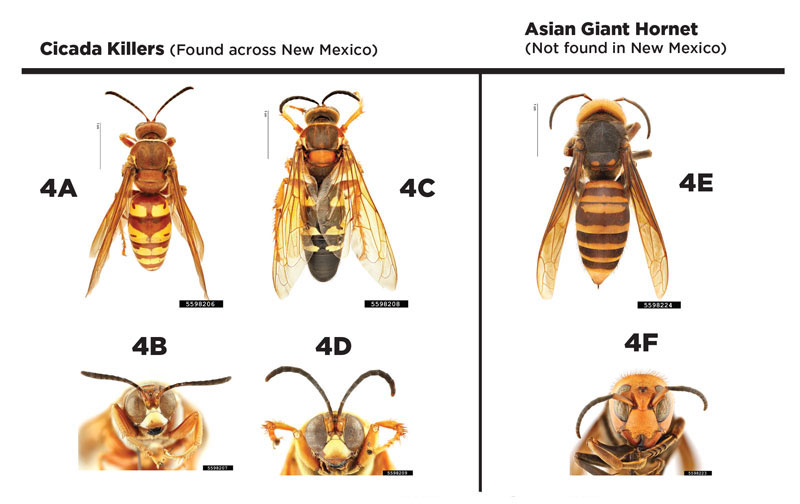Guide H-175
Amanda Skidmore and John R. Garlisch
College of Agricultural, Consumer and Environmental Sciences, New Mexico State University
Respectively, NMSU IPM Small Farm Specialist, Agricultural Science Center at Los Lunas; and Extension Agriculture Agent, Bernalillo County Extension Office, New Mexico State University. (Print Friendly PDF)
Background
In early 2020, the news was abuzz with an introduced species into the United States: Vespa mandarinia, dubbed the “murder hornet” by the media. Although the name “murder hornet” was given to these wasps, they are more commonly known by the less intimidating common names of “Asian giant hornet” or “giant sparrow bee” in their natural range (northern India to Eastern Asia). No Asian giant hornets have been found in the U.S. Southwest, and only a few have been found in the Northwestern United States in Washington, along the Canadian border. As of July 2020, the Asian giant hornet is NOT present in Albuquerque nor the state of New Mexico.
This quick information guide is designed to help identify the differences between Asian giant hornets compared to the large wasps commonly found in New Mexico and the Southwest. If you have questions after reading this guide about common large wasps in New Mexico or the Asian giant hornet, please visit the NMSU Cooperative Extension Service website (https://extension.nmsu.edu/) or contact your local county Extension agent (https://aces.nmsu.edu/county/).
What is the Asian Giant Hornet?
The Asian giant hornet (Figures 1A and 1B) was found in the Vancouver, Canada, and Seattle, WA, area in 2019. The Asian giant hornet has a distinctive yellow-orange head and body with coarse hairs and black and yellow-orange stripes on its body. It is about 2.5 inches long with a wingspan up to 3 inches. The hornets are extremely aggressive toward honey bees and other insects. A few hornets can destroy a honey bee hive quickly by decapitating honey bees and taking over the hive for their own offspring. Domesticated honey bees in North America have not evolved to efficiently defend their hives, but honey bees in Asia have evolved defensive strategies to protect their hives from Asian giant hornets.
Figure 1A. Asian giant hornet (Vespa mandarinia). Not found in New Mexico. (Photo by Hanna Royals, Museum Collections: Hymenoptera, USDA APHIS PPQ, Bugwood.org.)
Figure 1B. Asian giant hornet head. (Photo by Hanna Royals, Museum Collections: Hymenoptera, USDA APHIS PPQ, Bugwood.org.)
Is the Asian Giant Hornet a Threat?
Normally these hornets are not aggressive toward humans unless actively provoked. Those with severe allergies to insect bites and stings should take normal precautions when interacting with nature, including packing antihistamines with your hiking, camping, or gardening equipment. If you do have an allergic reaction to an insect bite or sting, seek emergency medical help immediately.
The Asian giant hornet should not pose an immediate threat to New Mexico. It is not close to New Mexico since it has only been found in Washington state. Also, it prefers temperate rain forests and not high desert climates or high elevations.
Common Large Wasps in New Mexico
There are several Hymenoptera species (wasps, bees, hornets, etc.) present in New Mexico. These wasps are not aggressive and normally pose no risk to humans or pets. Please act calmly around them and do not exterminate them. They serve as accidental pollinators because they forage for nectar from flowering plants, and are a sign of a healthy ecosystem.
The first common large wasp is the “tarantula hawk wasp” (Pepsis grossa, Figures 2A and 2B), which is the state insect of New Mexico. This wasp has a shiny black/blue body with orange-hued wings. The body itself is skinny, similar to the smaller paper wasps commonly found in the area, and is about 2 inches long. Although their size is dependent upon environmental conditions and food access, the wingspan of these wasps can be up to 3 inches across. They normally visit flowering plants to harvest pollen and nectar. They seek out tarantulas, stinging them and laying their eggs inside the tarantula. They normally do not attack or sting unless a person catches one or they are otherwise provoked.
Figure 2A. Tarantula hawk wasps (Pepsis grossa) seeking nectar from flowers. These wasps are found commonly across New Mexico, and are in fact our state insect. (Photo by Miranda Kersten, NMSU.)
Figure 2B. Tarantula hawk wasp seeking nectar from flowers. (Photo by Whitney Cranshaw, Colorado State University, Bugwood.org.)
The second common large wasp is the “cicada killer” wasp (Sphecius speciosus; Figure 3A), which is also found across the Southwest and the United States. Even though the word “killer” is in the name, it only targets the cicada, or “la chicharra,” insect. It does NOT pose a direct threat to humans or pets. These wasps are about 2.5 inches long with a plump body. They do resemble a hornet’s body: black in color with yellow stripes. The wings can be orange to brown in color and have a span of 3 inches. They live underground and prefer sandy soils, and may forage on flowers for sugar and water. They seek out cicadas, which they paralyze and bring back to their nests to lay their eggs inside (Figure 3B). They are often seen hovering near the ground or sandy mounds, sometimes carrying prey. Some are territorial and will scout out perceived changes in the environment, including hikers, gardeners, and pets. They will often make a loud buzzing sound, but are not a threat unless harassed.
Figure 3A. Cicada killer wasps (Sphecius speciosus) are found commonly across New Mexico. (Photo by Russ Ottens, University of Georgia, Bugwood.org.)
Figure 3B. Cicada killer wasp carrying a paralyzed cicada back to its nest. (Photo by Ronald F. Billings, Texas A&M Forest Service, Bugwood.org.)
Figures 4A through 4G give a side-by-side comparison of the Asian giant hornet and the common large wasps—cicada killer and tarantula hawk wasps—found in New Mexico. There is no direct threat to human life from any of these insects. If you have further questions, please contact your local county Extension office.
 Figures 4A–4G. Side-by-side comparison of western cicada killer wasp (Sphecius grandis; Figures 4A and 4B), eastern cicada killer wasp (Sphecius speciosus; Figures 4C and 4D), Asian giant hornet (Vespa mandarinia; Figures 4E and 4F), and tarantula hawk wasp (Pepsis grossa; Figure 4G). (Photos by Hanna Royals, Museum Collections: Hymenoptera, USDA APHIS PPQ, Bugwood.org [Figures 4A–4F]; and NPS/Brad Sutton, Flickr.com [Figure 4G].)
Figures 4A–4G. Side-by-side comparison of western cicada killer wasp (Sphecius grandis; Figures 4A and 4B), eastern cicada killer wasp (Sphecius speciosus; Figures 4C and 4D), Asian giant hornet (Vespa mandarinia; Figures 4E and 4F), and tarantula hawk wasp (Pepsis grossa; Figure 4G). (Photos by Hanna Royals, Museum Collections: Hymenoptera, USDA APHIS PPQ, Bugwood.org [Figures 4A–4F]; and NPS/Brad Sutton, Flickr.com [Figure 4G].)
References
Bachman, A. 2020, May 8. No, it’s not a murder hornet. South Dakota State University Extension. https://extension.sdstate.edu/no-its-not-murder-hornet
Identification Technology Program, USDA. 2020, May 28. IDaids support identification of the Asian giant hornet. https://idtools.org/news_05_28_2020.php
KOB Web Staff. 2020, June 30. Cicada killer wasps, not murder hornets, spotted in NM. KOB4 TV, Albuquerque, NM. https://www.kob.com/albuquerque-news/cicada-killer-wasps-not-murder-hornets-spotted-in-nm/5777483/
Kuchment, O. 2020, May 11. Get to know the Asian giant hornet, or ‘murder hornet.’ AgriLife Today, Texas A&M AgriLife Extension. https://agrilifetoday.tamu.edu/2020/05/11/get-to-know-the-asian-giant-hornet-or-murder-hornet/
Tamplin, H. 2020, June 17. Mistaken identity? Some Texans think mostly-harmless cicada killer wasps are Asian giant hornets. KXAN TV, Austin, TX. https://www.kxan.com/news/local/austin/mistaken-identity-some-texans-think-mostly-harmless-cicada-killer-wasps-are-asian-giant-hornets/
Townsend, L. 2012, July. Cicada killer wasps [Extension Bulletin Entfact-004]. University of Kentucky, College of Agriculture, Food and Environment. https://entomology.ca.uky.edu/ef004
Washington State Department of Agriculture. 2020. Asian giant hornet.
https://agr.wa.gov/departments/insects-pests-and-weeds/insects/hornets
For Further Reading
H-158: How to Collect and Send Specimens for Disease Diagnosis
https://pubs.nmsu.edu/_h/H158/
H-169: Using Insectary Plants to Attract and Sustain Beneficial Insects for Biological Pest Control
https://pubs.nmsu.edu/_h/H169/
H-172: Backyard Beneficial Insects in New Mexico
https://pubs.nmsu.edu/_h/H172/
Amanda Skidmore is the Extension IPM Small Farm Specialist for New Mexico State University. Her Extension and research program focuses on practical solutions for pest management in New Mexico, with a focus on specialty crops and pollinators.
John R. Garlisch is the Extension Agriculture Agent at NMSU’s Bernalillo County Extension Office. He earned his B.S. and M.S. degrees at the University of Illinois at Urbana-Champaign. His Extension work focuses on urban agriculture and local foods programs.
To find more resources for your business, home, or family, visit the College of Agricultural, Consumer and Environmental Sciences on the World Wide Web at pubs.nmsu.edu
Contents of publications may be freely reproduced, with an appropriate citation, for educational purposes. All other rights reserved. For permission to use publications for other purposes, contact pubs@nmsu.edu or the authors listed on the publication.
New Mexico State University is an equal opportunity/affirmative action employer and educator. NMSU and the U.S. Department of Agriculture cooperating.
July 2020, Las Cruces, NM










